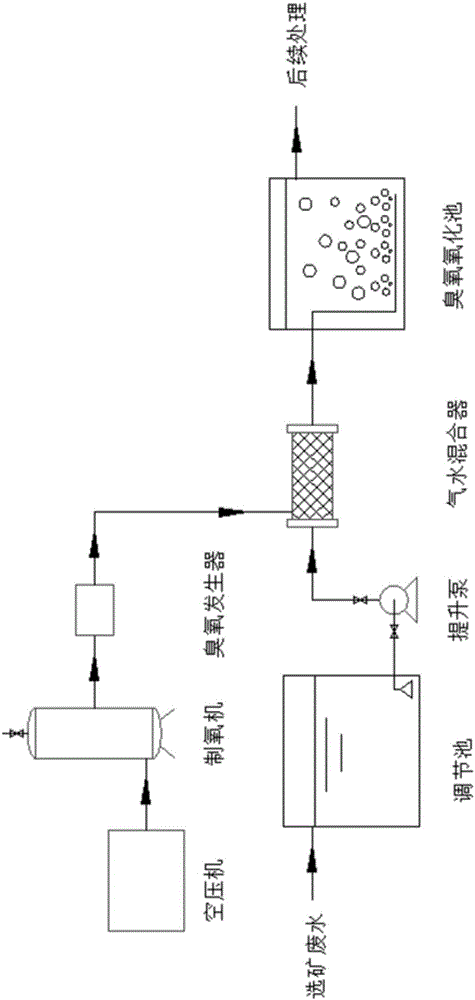Ozone shunting system in PAM-containing wastewater treatment system
A technology of wastewater treatment system and shunt system, applied in water/sewage multi-stage treatment, oxidized water/sewage treatment, water/sludge/sewage treatment, etc. Sludge increase and other problems, to avoid waste, improve treatment efficiency and reuse utilization, and reduce sludge sedimentation.
- Summary
- Abstract
- Description
- Claims
- Application Information
AI Technical Summary
Problems solved by technology
Method used
Image
Examples
Embodiment 1
[0025] see Figure 1-3 , the present invention is based on the fact that the COD treatment load of the wastewater is not high and the biodegradability is poor. Therefore, the physical and chemical treatment is selected in the subsequent process of ozone treatment, that is, the combined process of ozone pre-oxidation + coagulation sedimentation + sand filtration, to ensure that the effluent is stable and meets the water quality requirements of circulating water , to achieve wastewater reuse. The whole process adopts feedback mechanisms such as viscosity, turbidity, and ozone concentration in water to realize automatic control of chemical dosage, which is conducive to a virtuous cycle of water reuse.
[0026] The process flow of ozone + coagulation sedimentation + sand filtration process combination treatment for the reuse of PAM tailings wastewater is as follows:
[0027] The tailings wastewater containing PAM mainly comes from ore separation process drainage, tailings pond ov...
Embodiment 2
[0045] The original tailings reuse water of an aluminum mine factory contains polyacrylamide, which is reused after simple coagulation and sedimentation treatment, which often blocks the equipment pipeline system, increases the frequency of equipment cleaning and the work intensity of workers, and affects the production efficiency of the enterprise. To this end, we took water samples from the plant for small-scale experiments, and after several process combinations and comparisons, we finally selected the combined process of ozone pre-oxidation + coagulation sedimentation + sand filtration. Under the weakly alkaline pH value of tailings effluent, add ozone 1-4mg / L, react for 30 minutes, measure the viscosity in the water with a viscometer, control the viscosity within 1mPa·s, and add 120mg of PAC to the effluent into the coagulation reaction tank / l, depending on the size of the alum, adjust the dosage of PAC in real time or add a small amount of PAM to aid coagulation. After p...
Embodiment 3
[0050] The flooding wastewater of an oilfield contains a large amount of PAM. The wastewater has high viscosity, high oil content, and poor biodegradability. There is an oil separation-coagulation sedimentation treatment system in the field. Due to the continuous aging of the equipment, the environmental protection requirements are more stringent. The existing facilities The requirements could not be met, so the existing wastewater treatment facilities were upgraded. After careful analysis of the existing water quality and several small tests, and on the basis of making full use of the existing wastewater treatment facilities, the optimized design decided to adopt: oil separation sedimentation, ozone oxidation pretreatment and biochemical treatment processes, and the final treatment effluent is recycled.
[0051] The upgrading process is as follows:
[0052] After the oilfield flooding wastewater is collected into the regulating tank, it is first treated with oil separation an...
PUM
 Login to View More
Login to View More Abstract
Description
Claims
Application Information
 Login to View More
Login to View More - R&D
- Intellectual Property
- Life Sciences
- Materials
- Tech Scout
- Unparalleled Data Quality
- Higher Quality Content
- 60% Fewer Hallucinations
Browse by: Latest US Patents, China's latest patents, Technical Efficacy Thesaurus, Application Domain, Technology Topic, Popular Technical Reports.
© 2025 PatSnap. All rights reserved.Legal|Privacy policy|Modern Slavery Act Transparency Statement|Sitemap|About US| Contact US: help@patsnap.com



